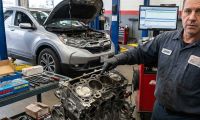Tesla's Model 3 and Model Y have redefined electric vehicles for the mainstream car market. Packed with cutting-edge technology, these cars offer a futuristic driving experience. However, for many potential car buyers, a crucial question lingers: how well will these new technologies hold up in the long run, and how reliable they are?
Finding concrete data on the long-term reliability of Tesla's innovative features can be challenging. Traditional car reliability ratings like J.D. Power and Consumer Reports often lag behind the rapid development cycle of Tesla's software-driven systems. These reports typically assess reliability within the first three years of ownership, making them less relevant for predicting long-term performance. Currently the 2022 Tesla Model 3's consumer-verified reliability score in J.D. Power is 79, which is slightly above average.
Also, know that Tesla's scores have fluctuated, with the Model 3 receiving an average rating from Consumer Reports. However, these reports primarily focus on traditional mechanical issues, which are less prevalent in EVs.
But Tesla has been fixing the reliability issues of its electric vehicles because in 2021 the Consumer Reports reliability rating for Tesla was second-worst.
A Spectrum of Reliability: Beyond Reports
A more nuanced perspective on Tesla reliability comes from real-world experiences. A 2023 Tesla Model 3 ownership survey by Bloomberg revealed that initial quality issues like paint imperfections were addressed swiftly, and major systems held up well over time. Owners reported minimal problems beyond minor inconveniences. This aligns with an article from Torque News, which highlights how Tesla addresses software glitches and improves features through over-the-air updates, potentially improving reliability over time.
Key Technologies and Their Long-Term Outlook: A Deep Dive
Let's delve into specific technologies within the Model 3 and Model Y, analyzing their potential reliability in 5-10 years:
-
Electric Drivetrain: Electric motors are generally considered simpler and more reliable than combustion engines. With fewer moving parts, they experience less wear and tear. Tesla's battery technology is constantly evolving, but improvements tend to focus on range and efficiency rather than core reliability. Battery degradation is a natural process, but advancements in battery management systems and thermal control, as detailed in a research paper by the National Renewable Energy Laboratory, should mitigate this over the next decade.
-
Autopilot and Full Self-Driving (FSD): These driver-assistance features are Tesla's most controversial offerings. Currently, they are classified as Level 2 systems, requiring driver supervision. Their long-term reliability hinges on software development and regulatory approval for higher levels of autonomy. While advancements are likely, as reported by experts at the Society of Automotive Engineers, achieving true self-driving functionality remains a complex challenge that may take longer than 5-10 years. The key to reliable FSD lies in robust sensor technology, advanced artificial intelligence, and clear regulatory frameworks.
-
Large Touchscreen Interface: Replacing physical buttons with a central touchscreen is a bold move. While convenient, these screens are susceptible to scratches, malfunctions, and software bugs. Their long-term reliability depends on the quality of the hardware and the stability of Tesla's software updates. User experience reports on forums like the Tesla Motors Club suggest that screen issues can occur, but the frequency of these problems remains unclear.
Tesla Reliability's Data Scarcity vs. The Advantage of Software Updates
The challenge of assessing long-term reliability lies in the limited data available for Tesla's rapidly evolving technologies. Unlike traditional cars with established platforms, Tesla's vehicles are constantly updated. This presents both a risk and an opportunity.
On the one hand, frequent software updates can introduce new bugs or glitches, potentially impacting reliability. However, Tesla's ability to address issues and improve features through over-the-air updates offers a significant advantage. Unlike traditional cars requiring physical fixes, Tesla can potentially rectify problems and enhance functionality remotely, potentially improving reliability over time.
The Importance of Maintenance of Your Tesla and Data Collection
This data-driven approach could significantly improve long-term reliability. Tesla has begun offering extended warranties for its battery and drivetrain, suggesting confidence in their longevity. However, independent repair shops may struggle to keep pace with Tesla's evolving technology, potentially impacting repair options in the future.
- The Role of Independent Repair Shops: Traditionally, a network of independent repair shops has offered consumers choice and potentially lower repair costs. However, Tesla's reliance on software and its control over diagnostic tools may limit independent repair options in the coming years. This could be a significant factor for some potential buyers to consider, especially as these vehicles age.
Looking Ahead: A Balancing Act
Tesla's innovative technologies offer a glimpse into the future of automobiles. However, their long-term reliability remains a question mark. The next 5-10 years will be crucial in determining how well these cutting-edge features hold up. Tesla must strike a balance between pushing technological boundaries and ensuring the robustness of its systems.
For potential buyers, a wait-and-see approach might be prudent. Early adopters may encounter unforeseen issues. However, those willing to embrace the cutting edge can benefit from Tesla's continuous improvement through software updates. By closely monitoring real-world experiences, maintenance data, and the development of the independent repair landscape in the coming years, we'll gain a clearer picture of the long-term reliability of Tesla's Model 3 and Model Y. This will empower consumers to make informed decisions about whether these vehicles are the right fit for their needs and preferences.
What Is The Lifespan of The Tesla Model 3?
Among other things three factors influence the lifespan of a Tesla Model 3: battery life, body and drivetrain and maintenance.
- Battery life: Tesla estimates the battery pack to last for 150,000 miles (Europe) to 200,000 miles (US), though some sources suggest it could reach 300,000-500,000 miles with proper care [1, 2].
- Body and drivetrain: Electric motors generally have fewer moving parts and experience less wear and tear than combustion engines, potentially leading to a longer lifespan for the overall drivetrain and chassis.
- Maintenance: Regular maintenance is crucial for any car, and Teslas are no exception. Following Tesla's recommended maintenance schedule can extend the lifespan of the vehicle.
While official data on Model 3 lifespans is limited due to the car's relatively young age, some real-world experiences suggest these cars can last for many years with proper care.
Here are some sources for further reading: How Long Do Tesla Model 3s Last? The Scoop on Vehicle Lifespan, and Owning a 2022 Tesla Model 3 RWD For 18 Months: Range Loss, Repairs, Fuel Cost, and More!
What Is The Lifespan of The Tesla Model Y?
Predicting the exact lifespan of a Tesla Model Y is tricky. While Tesla estimates the battery pack to last for 150,000 miles (Europe) to 200,000 miles (US), with proper care it could reach even higher numbers – some suggest 300,000-500,000 miles. The electric drivetrain, with fewer moving parts compared to combustion engines, also bodes well for longevity. However, the Model Y's young age means there's limited real-world data on long-term reliability.
Early adopters of the Tesla MOdel Y might encounter unforeseen issues, while those willing to embrace the cutting edge can benefit from Tesla's continuous improvement through software updates. Ultimately, the key to a long lifespan for your Model Y lies in proper maintenance and keeping a close eye on how Tesla's technology and the independent repair landscape evolve in the coming years.
While the long-term reliability of the Tesla Model 3 and Model Y remains a developing story, the outlook is cautiously optimistic. The simplicity of electric drivetrains and Tesla's ability to refine systems through software updates are positive signs. However, the newness of these technologies and the evolving service landscape require further observation. For potential buyers, closely monitoring real-world experiences, maintenance data, and the development of independent repair options will be crucial. By staying informed, you can make a confident decision about whether the Tesla Model 3 or Model Y aligns with your long-term needs and preferences.
If you have any questions or tips on how to improve the long term reliability of the Tesla Model 3 and Model Y vehicles, or have a personal experience with the reliability issues of these vehicles, please discuss them in the comments section below. I would greatly appreciate the your input to make this article even more helpful and useful incorporating your experience with these popular electric Tesla vehicles.
Armen Hareyan is the founder and the Editor in Chief of Torque News. He founded TorqueNews.com in 2010, which since then has been publishing expert news and analysis about the automotive industry. He can be reached at Torque News Twitter, Facebook, Linkedin, and Youtube. He has more than a decade of expertise in the automotive industry with a special interest in Tesla and electric vehicles.











